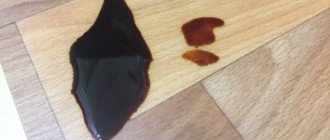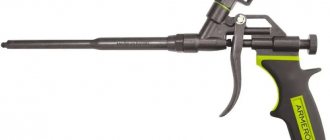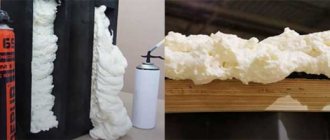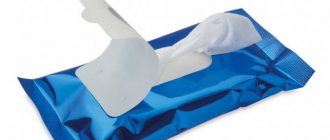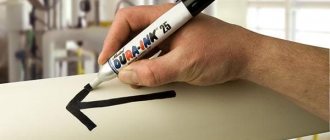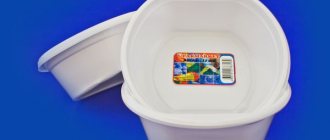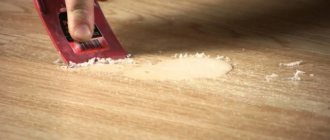During renovations, it is not always possible to keep the apartment clean. It will be difficult to wipe off polyurethane foam from linoleum if it has already dried. Fresh stains are easier to deal with, so it's best to act quickly. To restore the floor to a neat appearance, folk remedies and professional compounds are used. The first ones are cheaper, the second ones are more effective, they are usually used in cases of large-scale pollution.
How to remove fresh marks
Polyurethane foam does not harden immediately. If its particles get on the linoleum, it is better to let the polyurethane set a little, and then carefully pry the ball off the edge with a thin knife blade and remove it. In the event that the foam is accidentally smeared on the floor, it can be removed by using silicone cream or vegetable oil.
Any of these products are applied to the stained area, and then carefully collected together with a sheet of thick paper, moving towards the center of the stain, and transferred to another sheet. Both silicone and oil will prevent the foam from smearing even more, enveloping its particles. After cleaning, it is advisable to rub the linoleum in the cleaned area with wax or protective polish. In this case, there will be no trace of contamination left.
Recommendations
In almost all cases, polyurethane foam can be removed from linoleum, even if it has hardened. But if you listen to the recommendations of professionals, cleaning the surface will be much easier:
- Before starting work with foam, the linoleum surface is completely washed, wiped and a little linseed oil is applied. If you don’t have it, you can use laundry soap in the form of a fine powder.
- Another option is to cover the surface with film. This is the most reliable coating. You can simply rub it with wax - then the work will be as convenient as possible, and even if foam gets on the surface, it will be very easy to clean.
- When applying polyurethane foam, work only with gloves. In this case, the floor or other surface must be perfectly dry. Even if there are just drops of water on it, the foam will stick very strongly and will not be easy to clean.
- Before starting work with polyurethane foam, be sure to purchase a cleaning agent. It is almost inevitable that excess material will get onto linoleum. Cleaning it is not always easy. But if you remove the foam immediately after finishing the work, this will not require much effort.
- If it is necessary to urgently clean the contamination, you should not work with the fresh mass with a spatula or other tools. In this case, a film will remain on the surface, and it will spread over a large area and will be visible. Then you will have to change part of the linoleum.
- If you can’t remove the liquid, not yet hardened foam, you just need to leave it for 30-60 minutes. Even if it is smeared over a large area, dry material is much easier to clean. It's better to wait a little than to take risks.
Traditional methods for removing dried foam
Traditional methods mean removing foam using means that are not at all intended for such purposes. However, certain substances successfully cope with this task. First, you need to remove the bulk of the frozen foam using a utility knife, leaving as thin a layer as possible on the floor. Then you can begin the final cleaning.
"Dimexide"
"Dimexide" can be purchased at the pharmacy chain. The drug is a liquid medicine for external use. They sell Dimexide at a very affordable price.
How to apply the substance:
- The composition is applied to the stain directly from the bottle, and then distributed with a brush over the entire area of the stain.
- After this you should wait 2-3 minutes.
- The softened mass is rubbed off using an abrasive sponge, plastic or wooden spatula.
- Then the floor area is wiped clean with hot water and liquid soap.
"Dimexide" requires careful handling. Always work with it using rubber gloves. If the drug gets on unprotected skin of your hands, it can cause harm.
Pros and cons of using
Today, almost every home has PVC windows installed or plans to install them. During the installation process, polyurethane foam will definitely be used, since it is a reliable sealant.
Its unique ability to penetrate even the tiniest cracks, the ability to seal seams and glue parts are the main advantages of the material. At the same time, it has moisture-, heat- and sound-proofing properties.
Despite the many advantages of this material, it has a small drawback, which is the difficulty of laundering. If the sealant gets on surrounding objects during work, then it is quite difficult to correct the situation. Many people wonder how to remove polyurethane foam. There are various effective ways. The choice of method should be based on the coating material.
Vegetable oil
Vegetable oil can remove both fresh and dried foam. Especially if you warm it up (things will go faster).
Application to the surface is carried out using a paint brush:
- The oil should be evenly distributed.
- After this, wait approximately 20 minutes.
- Then the foam is scrubbed off using a hard sponge, a plastic spatula and other available means.
- Any oil remaining on the floor is removed with a paper towel.
- Then wipe the cleaned area with a damp cloth.
This method of removing dried foam is simple and accessible and does not require any costs. After all, vegetable oil is found in every home.
Vinegar
Using vinegar is not the most suitable option for cleaning linoleum from polyurethane foam, but you can try it. Vinegar can soften a stain that is not too old. But at the same time, the sealant should not be heavily smeared on the floor.
You should not use concentrated vinegar essence, it can ruin the flooring. You can try scrubbing the polyurethane foam with regular table vinegar. Acid can soften the foam. If this method is unsuccessful, try other options.
How to clean: effective ways
It is not for nothing that foam removal products are presented in a wide range on the construction market. In each specific case, it is necessary to use a specific tool. Let's consider several options for removing foam from surfaces of different materials, taking into account different door coatings.
Metal with paint
A metal door that is powder coated or painted with baked hammer enamel has a particularly durable paint layer. Solvents will not damage it.
You should not try to remove the foam until it is in a polymerized state. This will result in a larger smudged area on the door. You need to wait until the entire surface of the lump is covered with a film and dries a little. Then you must carefully grasp the resulting ball and break it off.
If the foam did not get in as a droplet, but rather spread out like a fur coat, you can cut it off with a sharp painting knife. The defective area should be cleaned with a fine abrasive to avoid leaving scratches. This will help clear out any remaining foam.
If a stain remains, it is better to treat it with a suitable solvent from the list. If it is possible to buy a foam remover from the same manufacturer whose product was used when installing the door, this will be the best solution. It is necessary to carefully read which surfaces cannot be treated with the proposed composition.
Varnished
It is imperative to wait until the foam polymerizes into a thick dough or soft rubber. By lightly pulling the top of the lump, you should separate the foam from the stained surface. Typically, such manipulation does not leave any traces on the surface of the door. Small splashes can be easily removed with a dry microfiber cloth. If there are traces of foam left, you can soak them with dimexide (it softens the foam in 2-3 minutes) and remove the remains with a napkin. If the varnish becomes cloudy, it can be polished using regular furniture polish.
Veneered and eco-veneer
These materials have a textured surface. If you try to use dimexide to remove polyurethane foam, it can destroy the pattern that imitates wood fibers. Therefore, you should first try mechanical cleaning of the surface. To do this, you can use a knife or a plastic spatula. You can try to lightly clean the surface using a fine-grain abrasive.
After mechanical cleaning, the surface must be washed with a damp sponge, using the hard side, and then wiped dry with a clean cloth. To consolidate the result, the surface is treated with a soda solution.
Glass base
Decorative displays enhance the appearance of any design element. But when sprayed with foam gets on them, they lose their decorative appeal and seem sloppy. To clean glass from polyurethane foam, first use a mechanical method of cutting off the defect with a sharp paint knife.
If a foam stain remains on the surface of the glass, apply a few drops of vegetable oil to it. This will soften the foam. The stain is wiped with the hard side of a household sponge, then the surface is wiped dry with a cloth napkin.
iron door
This surface is the most unassuming. Foam from it is usually considered mechanically. Do not touch the contaminated area until the installation compound has completely dried. After this, remove particles of dried foam with your hands. If stains remain, the foam in the contact areas is removed by sanding with a fine abrasive or a solvent that does not affect the metal coating.
Wooden surface
Recommendations for cleaning a wooden surface are the same as for cleaning a varnished surface. The task is simplified by the fact that the surface of the wood is usually matte. If after cleaning there is a small stain left that differs in color from the rest of the surface, you can use a furniture wax chalk of a suitable color. Such crayons are sold in any specialized furniture fittings store. A simple application of chalk gives a matte finish.
Applying furniture wax in molten form allows you to obtain a shiny surface that is as close as possible to a varnished surface. After application, it can be polished if the decorative coating requires it.
Special preparations
Specialized products cope well with traces of polyurethane foam and allow you to quickly remove dirt without damaging the linoleum. Their only drawback is their relatively high price. It is logical that in this case, compositions for cleaning construction guns, with which polyurethane foam is applied, are effective.
"Ultima professional"
The product cleans surfaces well from fresh foam. You can also use Ultima professional on linoleum. The product is produced in cylinders with a volume of 500 mm. Today the price of the purifier is on average 480 rubles.
"PENOSIL"
The drug is packaged in cylinders with a volume of 500 m. It is used to remove the remains of fresh foam from a gun, spatulas, and various surfaces. The product does not require aging, as it acts immediately after application. The average price per package is 445 rubles.
"BeLife FOAMCLEANER"
The drug is available in aerosol form and is effective in removing uncured foam from the mounting gun and surfaces. Can even be used for clothing. If necessary, the aerosol is reapplied. The price for packaging a 500 ml cylinder is a little more than 180 rubles.
"TYTAN PROFESSIONAL"
A multifunctional product that removes not only polyurethane foam, but also polyurethane-based adhesive. Ideally cleans mounting guns and any surfaces. Can be used for degreasing before applying foam. The only condition is that the contamination must be fresh. The product is sprayed, then the surface is wiped with a dry cloth. The cleaner is available in a 500 ml bottle and costs a little more than 1,000 rubles.
"PENO-OFF"
Super effective, powerful cleaner. Even copes with dried foam. Due to its caustic composition, use the product with precautions. Do not allow the composition to come into contact with the skin of your hands. Do not leave the product on linoleum for a long time. As soon as the foam dissolves, the dirt should be washed off immediately and then wipe the area with clean water. A 340 ml can of product can be ordered for 276 rubles.
"Mellerud"
The product is available in a 500 ml bottle. Its purpose is to remove remnants of uncured and dried polyurethane foam from various surfaces. Cleaning of frozen contamination takes place in 1.5 hours. The product is applied undiluted with a brush onto traces of foam. After 90 minutes, clean the floor with a hard sponge and then wipe clean with a damp cloth. The cleaner costs 1050 rubles.
"Platina Cleaner"
The cleaner is designed to remove foam residues from the mounting gun, spatulas and other tools. It is also suitable for linoleum. The product softens polyurethane and allows you to easily get rid of it. Sold in 500 ml bottles, costs about 450 rubles.
"Purex"
"Purex" copes with hardened foam. The product is produced in the form of an acetone-based paste. The cleaner does not damage the linoleum coating, but only interacts with polyurethane. After cleaning, there are no scratches or marks left on the surface. The paste is applied to the dirt in a layer 1 mm thick, after an hour the linoleum is wiped with a damp cloth. The product costs 360 rubles per package.
"HOBBY"
An inexpensive product, sold at a price of 65 rubles per 250 ml aerosol can. Spray onto fresh foam and then easily remove it from the surface. It will take 5-10 minutes for the solvent to take effect. The cleaned area is wiped with a damp cloth so that no streaks remain.
Effective removal products
The market for professional cleaning products has many suitable for cleaning polyurethane.
"BeLife FOAMCLEANER"
“BeLife Foamcleaner” is an aerosol product specially created for cleaning. Designed for foam that has not yet hardened, it can even be used to clean the mounting gun. Spray the product for 15–25 minutes, then remove the stain with the product using a napkin or rag.
When working, you must follow safety precautions and use safety glasses, clothing, and waterproof gloves.
What not to do
Without an accurate understanding of the properties of foam, you can make a number of mistakes during cleaning, which will only aggravate the situation.
Here are the most common ones:
- Do not rub the area contaminated with fresh foam with a rag, as this will smear it even more on the linoleum and it will be more difficult to get rid of the stain. It is better to let the ball harden a little and then carefully remove it, then cleaning off the layer of polyurethane stuck to the floor.
- Before using a solvent for removal, you must read the instructions for it. Some products are not designed to work on surfaces such as linoleum. An aggressive composition can damage the protective layer or even partially wash off the design.
- It would be a mistake to remove foam without wearing protective gloves. All cleansers are unsafe for the skin of your hands.
- Varnish and paint thinners are not suitable for dissolving polyurethane foam; they can also dissolve linoleum.
- You need to scrub off the softened foam effortlessly using plastic or wooden scrapers or a sponge with a hard layer. If you use metal tools such as knives, razor blades, etc., you can damage the flooring.
- When applying a special product, it is necessary to strictly adhere to the application time recommended by the manufacturer. If the composition is left to act longer, the base may be damaged.
Purchased cleaners must be used strictly for their intended purpose. A solvent for fresh foam will not cope with an old stain.
Variety of works and methods of surface protection
The use of polyurethane foam in modern construction is very popular due to the many positive qualities of this material.
The need to create a moisture- or air-tight layer, to fill gaps or cracks forces craftsmen to resort to the use of polyurethane foam, which perfectly copes with the task when:
- sealing seams and joints;
- filling voids;
- creating thermal insulation;
- used as a sealant.
There are situations when a foaming composition is used for gluing various materials. Due to the popularity of foam made for installation work, it is widely used by both professional builders and those who do repairs themselves without seeking help from specialists.
There are certain rules that must be followed when working. They will help to avoid unforeseen situations and contact with various surfaces.
Failure to follow approved instructions results in property damage.
To do this, simply cover the floors and walls with plastic film or other waterproof material.
If the foaming composition does end up on the floor, then the question arises of how to clean the mounting foam from the linoleum without damaging the coating.
In answering this, you should draw the consumer’s attention to the fact that different cleaning agents have been created for fresh or already hardened compositions.
Advice from professionals
People whose profession involves frequent use of polyurethane foam know well how best to keep linoleum-covered floors clean.
They advise the following:
- You can protect the linoleum in advance by applying linseed oil to it at the place of work with foam or rubbing it with a crumb of simple soap;
- for protection, you can also use oilcloth or thick paper, covering the desired area;
- to make sure that the cleaner will not damage the flooring, it is better to test it in advance on a small area of linoleum hidden from view;
- after washing the foam, the linoleum must be rubbed with wax or a protective coating to restore the shine of the surface;
- the effect on linoleum depends on the type of coating; for multilayer material it is necessary to choose more gentle means;
- After application, the solvent can produce harmful fumes; it is better to use it with the window open.
Do not throw away linoleum scraps after laying it. On small pieces of material you can safely test the effects of one or another solvent. When cleaning, it is better to proceed slowly so as not to accidentally catch the base.
To prevent the floors from becoming contaminated with polyurethane foam, it is better to cover them in advance with oilcloth or old newspapers. If contamination does occur during work, improvised and professional products will help you deal with it; they must be used with care. Having done everything according to the rules, you can completely clean the flooring without causing harm to it.
How and how to remove hardened polyurethane foam from linoleum
Removing dried polyurethane foam from linoleum is even easier than removing soft foam. When the material has hardened, it is simply scraped off the surface. You need to act carefully so as not to damage the linoleum itself. It is recommended to clean the foam using a spatula, the edge of which is treated with dimexide. There are two options:
- If the material is still relatively fresh, it will stretch like rubber cement. After scraping, you need to clean the mark on the linoleum using a remover. It is allowed to use dimexide. Then wash with hot water and soap.
- If the foam is dry, you can simply scrape it off, like old paint. To do this, take a rubber or plastic spatula. Metal cannot be used, otherwise the coating will be severely damaged, even if you work very carefully.
For work you will need rubber and wooden spatulas. The first performs the function of a scraper, the second is used as a scoop, in which the remains are transferred to a bucket.
After removing the stain, marks will remain on the surface. They need to be washed with warm water and liquid soap. But it’s even better to use a special solvent that will help quickly clean the foam from linoleum and will not leave streaks.
After removing contamination, the floor is thoroughly washed and cleaned with a solvent.
Parquet and parquet boards
Floor coverings made of parquet and parquet boards are painted and varnished to protect against moisture and highlight the structure of the wood. Aggressive chemical components corrode the varnish if used on a parquet floor. To better remove stains, complete polymerization must be prevented. As soon as the polyurethane dries slightly and stops sticking to your hands, you need to carefully pull the edge of the foam mass and tear it away from the parquet. Traces can be removed with any cleaning agent.
If the mass has hardened greatly, cut off the remaining sealant with a knife. The area of contamination is treated with Dimexide solution. After 15 minutes, the mounting foam will be easily wiped off, and no traces of dirt will remain on the varnished surface. Before applying chemical compounds, you should check their effect on the parquet in an inconspicuous place. If the varnish is destroyed, it is better to choose Dimexide.
Carpets
Soft textiles and fleecy fabrics easily bond with polyurethane sealant, which penetrates into the fibers, and it will be difficult to remove dried foam with a knife or scraper. In addition, there is a risk of damaging the material.
Depending on the type of carpet, you can clean the foam in the following ways:
- Carpet - the remains are carefully cut off with knives closer to the surface of the floor covering and thoroughly washed with water.
- Carpet with pile - cover with a wet rag to soften it, then scrape it off with a spatula.
- Lint-free carpet - use varnish solvent, acetone or Dimexide. After treatment, the carpet is washed with detergent.
If the dirt has become deeply embedded in the fleecy fabric, part of the pile will have to be cut off or plucked out. Foam is easier to clean from carpet, but fabric coverings after treatment with chemical compounds must be washed or dry-cleaned so that a specific odor does not remain.
